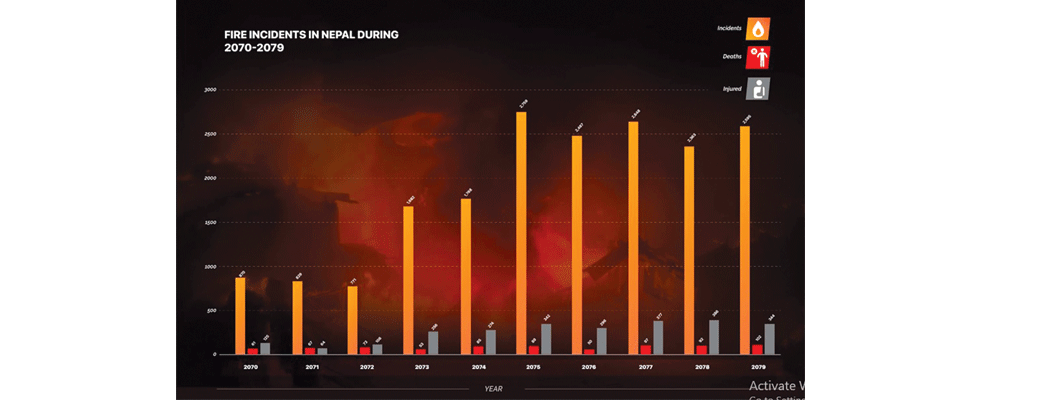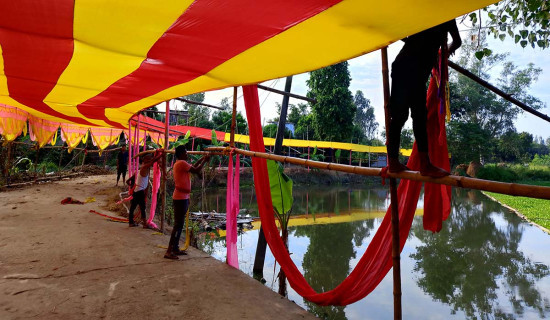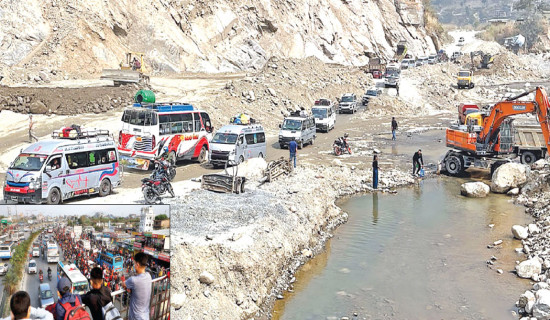- Friday, 24 October 2025
Fire indents flare up threefold in 10 years
Kathmandu, Apr. 2: In Nepal, spring is the season commonly known for forest and household fires. The hot and dry spell looms, fanning the flames anywhere across Nepal at any time.
On average, 77 people get killed every year in Nepal due to forest and other fire-related incidents, according to government statistics.
Damages caused by fire, including loss of human lives in the last 10 years from 2014 to mid-March, 2023, fire incidents and death reports as made public by the National Disaster Risk Reduction Management Authority (NDRRMA) on March 23 at Singha Durbar, have been recorded high with a threefold increase during the decade.
Altogether 18,772 fire incidents took place in Nepal from 2014 to mid-March 2023, in which a total of 769 people were killed and 2,548 got injured, according to the NDRRMA. The financial loss amounted to more than Rs. 22.23 billion in the same period.
Anil Pokharel, Chief Executive Officer (CEO) of the National Disaster Risk Reduction and Management Authority, said that not only people have lost their lives with the increasing incidents of wildfires, but also the economic losses it caused are the second largest after the losses incurred due to damage of infrastructure by the 2015 earthquake.
Forest expert and Under Secretary at the Ministry of Home Affairs (MoHA) Sundar Prasad Sharma said, “Though the details of the physical damage seen from the outside are certain, there is no account of the damage of the wild animals and birds, which are priceless treasures in the forest.”
Sharma said that although a few days of rain has given relief from the fires that have increased due to the prolonged drought, the period till May is full of dangers.
“Forest fires occur globally on various scales every year, causing economic, social, ecological and environmental damage. In a developing country like Nepal, a critical review of policy envisions and its translation concerning the prevailing wildfire scenarios is lacking which is crucial for sustainable forest fire management,” he said.
Forest fire study report
A study published in a ‘Journal of Forest and Livelihood: Status and Practical Implications of Forest Fire Management in Nepal’ in June 2022 shows that about 58 per cent of forest fires are a result of deliberate burning by grazers, poachers, hunters, and non-timber forest product (NTFP) collectors, 22 per cent due to negligence and 20 per cent by accident in Nepal.
Likewise, more than 80 per cent of forest fires occur in March and April whereas about 60 per cent forest fires occur in April alone. The study is based on the online data sources from Global Forest Watch (2021).
The season of forest fires has just started, said Under Secretary and Spokesperson for the NDRRMA, Dhruba Bahadur Khadka. As the mercury rises and rainfall has not happened in the past several months, the number of fires could rise by five times throughout the country in the coming days. Therefore, everybody needs to be careful, he said.
Extended dry season
Nepal has received no measurable rain since early October. Dry conditions and higher temperatures increase the likelihood of fire incidents. “The dry season has extended in Nepal and that’s a fact,” said Bhushan Tuladhar, an environmentalist. “This has not only contributed to fire incidents, but also poses a serious threat to human life and property as well as to wildlife.”
In the year 2022, there were a total of 2,363 fire incidents, and by March 15 of this year (2023), this number has already increased to 2,595.
Experts are saying that the incidence of wildfires may increase by five times this year due to less rain in winter and lower humidity in the environment due to the increase in the average temperature of the winter season compared to previous years. Even now, the locals have no other option but to douse the forest fires in the remote mountains with hand-made green-leaves broomsticks.
“Incidents of fire have just started. More incidents could happen this year, as the country has had a prolonged dry spell,” said Bhupendra Das, an air quality expert at Clean Air Asia, an international non-governmental organization. “Wildfires or forest fires not only cause loss of lives and properties; they also inflict damage to the environment and ecology.”
Fire export Sharma added that Nepal is one of the most vulnerable countries to the impact of climate crisis, and besides adapting to its impact it should also be doing its part to reduce emissions and increase forest cover.
Most wildfires are caused by careless disposal of cigarette butts, funerals inside the forests and locals not extinguishing flames after picnics. Livestock owners also deliberately set the undergrowth on fire believing that it will bring up fresh new shoots of grass when the rains come, Sharma said.
Farmers also have a role in increasing wildfires as they set fire to residual straw after harvest, not realising that it can be composted to make bio-fertiliser. Some forest fires are set by poachers to clear the vegetation and catch wildlife for smuggling, said environmentalist Bhushan Tuladhar.
Weak implementation efforts Even though the incidents of fire are increasing every year, plan of the government is not seen so effective yet. If a fire breaks out in a skyscraper in Kathmandu Valley, the government does not have the means to extinguish the fire. The available fire engines can put out fires of only eight to 10-story buildings.
CEO Pokharel was of the opinion that everything could not be done because they were the body to make and execute plans and policies. Pokharel said, “We don’t directly buy a fire engine, nor any other goods. We make the policy and vision only; the government does purchase the means that are required which are distributed and managed accordingly.”
Only three years ago, the government had introduced the ‘one local level, one fire engine’ programme to control fire incidents. However, that programme failed to materialise.
Fire engines cannot reach densely populated areas. As the fire cannot be brought under control in time, lot more physical and sometime humanitarian life could be damaged.
CEO Pokharel said that initiatives, including structural reforms, transfer of equipment, development of information system, effective communication, and local-level training among volunteers and staff members are being carried out for fire mitigation and management.
A system has been in operation to organise all the information on a single portal in order to receive details about all types of disaster risk including fire, forest fire, lightning and conduct mitigation and management activities accordingly. bipadportal.gov.np operated by the authority has arrangements for collection, analysis and storage of information and data related to disaster management, he said.
Fire-fighting equipment to 21 districts
The authority has procured materials required for fire and forest fire control and distributed them to various district administration offices and local levels. So far, 21 district administration offices have been given a set of fire-fighting equipment, including a portable fire-fighting pump, which can flow water up to two kilometers distance from the nearby water source.
Apart from pumps, the distributed equipment sets include fire swatters, fire racks, fire axes, first aid kits, fire-fighting jump suits, fire boots, helmets, back pack jumps, head torches, shovels, among others.
The district administration offices where the equipment have been distributed include Ilam, Bara, Parsa, Sindhuli, Makwanpur, Chitwan, Nawalparasi East, Nawalparasi West, Palpa, Arghakhanchi, Pyuthan, Dang, Salyan, Surkhet, Banke, Bardiya, Achham, Kailali, Doti, Dadeldhura and Kanchanpur.
Similarly, Abukhaireni and Bandipur Rural Municipality of Tanahun, Bahrabishe Municipality of Sindhupalchowk, Barahapokhari Rural Municipality of Khotang, Manthali Municipality of Ramechhap and Ratnanagar Municipality of Chitwan have also been provided with sets of equipment used in fire control along with pumps.
Portable fire-fighting pumps have been handed over to District Administration Office Rasuwa and Sindhupalchowk and Saptari’s Tirhut Rural Municipality and Taplejung’s Phungling Municipality and Mirangden Rural Municipality.
The Authority has prepared an information system to mobilise fire fighter volunteers in an institutional manner for all types of disaster risk reduction and response, including fires and forest fires. The work in this regard started after the 12th meeting of the Disaster Risk Reduction and Management Executive Committee held on January 28, 2022 passed the ‘Disaster Management Volunteer Bureau Formation and Operational Guideline-2022’. So far, 100,411 volunteers have been registered on the web platform https://vms.ndrrma.gov.np/ prepared for that.
Subsidy distribution guideline for reconstruction and rehabilitation of private residences of those affected by monsoon and fire disasters is in effective implementation, said CEO Pokharel.
As per the guideline, disaster victims who lost their homes due to fires and monsoon-induced disasters will receive Rs. 300,000 in Terai districts, Rs. 400,000 in mountain districts and Rs. 500,000 in hilly districts. As of February 15, 2023, Rs. 1.139 billion has been disbursed from the federal government for reconstruction and restoration of private housing.
Need of aerial fire-fighting technology
Not all types of fire can be extinguished just by sitting on the ground or reaching the spot. For this, the government requires fire fighter helicopters which can use fire buckets for carrying water and chemical with spraying technology.
Rather than adopting every possible measure to control fires, the Authority is preparing to increase public awareness to prevent fires as most forest fires occur due to human or man-made errors.
















